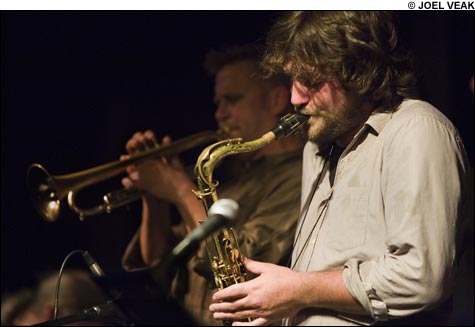
FRESH: Preminger floats like a butterfly and stings like a bee. |
WFNX Jazz Brunch Top Five
1. ROY HARGROVE, Earfood [Emarcy]
2. PATRICIA BARBER, The Cole Porter Mix [Blue Note]
3. MCCOY TYNER, Guitarists [Half Note/McCoy Records]
4. CLAUS OGERMAN/DANILO PÉREZ, Across the Crystal Sea [Emarcy]
5. AARON PARKS, Invisible Cinema [Blue Note] |
Noah Preminger — bearded, shaggy-haired, 23 years old — plays tenor saxophone like a man at least twice his age while remaining completely of the moment. At Scullers on September 9, appearing behind his new Dry Bridge Road (Nowt Records), he led a line-up that included veteran pianist Frank Kimbrough and guitar wizard Ben Monder, plus trumpeter Russ Johnson, bassist John Hebert, and drummer Jochen Rueckert. Plenty of younger players extol funk, hip-hop, or rock backbeats. Preminger is pure jazz without being a fuddy-duddy. Instead of the brawn and bray of Coltrane, he likes silky floating beboppish lines in the manner of Lee Konitz and Warne Marsh. (The band played Konitz & Marsh’s “Sax of a Kind,” and its trim unison theme fit like a glove.) There was plenty of rhythmic variety — Preminger’s “Luke” mixed call-and-response sections of 4/4 and 6/8. Kimbrough, Hebert, and Rueckert found all manner of ways to vary standard 4/4 pulse, Hebert stepping out of his walks for syncopated counterpoint to Rueckert’s swinging ride and snare, Kimbrough stepping in with odd-beat chords. Monder varied a blurry classic jazz tone with some fuzzy distorted (but still quiet) rock guitar, especially on the last — and most freewheeling — tune of the night, Joe Lovano’s “Uprising.”Preminger’s lines are always fresh. He likes to start a solo with a long burry low note and then accelerate up through the registers, from his pearly mid range to a top-of-the-horn rasp. And he varies his phrasing — one of the things that make a ballad like “Where Seagulls Fly,” from the album, sound older than Preminger’s years. He’ll use space and tone not to mimic some older balladeer like Ben Webster or Lester Young but to find his own emotions and thoughts, inventing new riffs, new harmonies, in the midst of his melodic embellishments. He starts and stops his eighth-note runs, mixing in plenty of rests or longer tones, and he’s especially good at the blues procedure of “additive” phrasing, which gives his solos a motivic logic. Think of his rhythmic embellishment as a lyric and you get the idea:
When I . . .
When I see . . .
When I see you again. . . .
This was not mainstage jazz — but small-room jazz whose intricacy and delivery packed a punch nonetheless. Preminger’s ballad “Today Is Tuesday” was almost unbearably slow, with on-the-beat little melodies and a beautiful out-of-phase section for trumpet and tenor that led to an extended passage of call-and-response. To play music this detailed and soft-spoken these days is as radical as the most transgressive squall of old-school avant-garde.
At Ryles a week ago Wednesday, the quiet but forceful linchpin of another scene — another “subculture” — held court. This was five-string electric-bassist Fernando Huergo, who plays in more pan-American bands (as in Spanish and Portuguese) than I can count — singer-songwriter Marta Gómez’s band, Sergio Brandão’s Manga-Rosa, the Afro-Cuban band Enclave, and Guillermo Klein’s Los Guachos big band, to name a few. But it is Huergo’s own “jazz Argentino” that is closest to his heart, a blend of jazz harmonies and improvisation with Argentine milonga, tango, and chacarera. At Ryles, he was joined by the band from his latest album on Sunnyside, Provinciana: flutist Yulia Musayelyan, saxophonist Andrew Rathbun, pianist Mika Pohjola, and drummer Franco Pinna.
Although Huergo’s tunes are based on dance rhythms, you probably couldn’t dance to them, not even if you’re from Argentina. “Instinto Matero” mixes alternating sections of Argentine chamamé with funk, “One in Ten” bumps along on a 10/8 chacarera, and the title track from the new album, introduced by Huergo’s power-chord fifths, fakes left with 6/8 malambo before falling into 4/4.
Those formal schemes don’t begin to suggest how catchy Huergo’s melodies can be, and the irresistible tug of his grooves, no matter how ambiguous the meter. He knows how to keep you dancing in your seat. At Ryles, you could also hear why he’s such an in-demand bassist. The first tune of the night, his “Chacarera Boogaloo,” honored the classic Blue Note boogaloos of Herbie Hancock and Lee Morgan. As Pohjola solo’d, Huergo’s bass danced in tandem, outlining the beat with Penna, but also spinning off countermelodies, coloring chords with bass-baritone low notes and guitar-tenor highs.
Rhythm as much as anything else (melodic variation, chord progressions) accounts for the tension and release in Huergo’s songs. But Penna’s “Bochis” (from both the album and the band’s second set at Ryles) is apposite, mixing passages of exaggerated syncopation with a smooth, legato triple meter. Meanwhile, Huergo’s bandmates have grown into this music wonderfully. Musayelyan is a flutist with beautiful tone who’s nonetheless not so in love with her own sound that she doesn’t shape her lines with rhythmic incisiveness. Rathbun’s soprano solos are full of attractive Wayne Shorter–like hesitations and rests. And on “El Chupacabras,” he got to break out of the chacarera rhythm for a torrid passage of 4/4 swing, Huergo running right along with him. Sometimes straight swing is a good thing too.